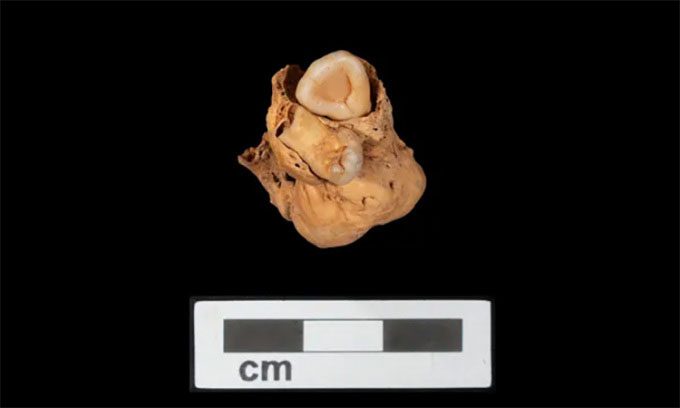A teratoma the size of a large grape was found in the pelvic region of a girl aged approximately 18 to 21 years old.
Archaeologists discovered a pelvic tumor in the remains of a girl who died over 3,000 years ago while excavating the North Desert cemetery in the ancient city of Amarna, Egypt, as reported by Live Science on November 7. Gretchen Dabbs, a biological archaeologist at Southern Illinois University Carbondale, along with her colleagues, announced this rare finding in the International Journal of Paleopathology.

The teratoma with two teeth. (Photo: A. Deblauwe/Amarna Project)
Based on the fact that the tumor contained two teeth and its location within the pelvic region, the research team concluded that this is a ovarian teratoma. This is the oldest recorded example of a teratoma. According to the Cleveland Clinic, teratomas can be benign or malignant and are often composed of various tissues such as muscle, hair, teeth, or bone. They can cause pain, swelling, and infection if ruptured. Currently, the typical treatment method is the removal of the tumor.
Previously, only four cases of teratomas had been documented in archaeology, three in Europe and one in Peru. This new discovery marks the fifth case worldwide and the first in Africa.
The teratoma is roughly the size of a large grape. The girl with the tumor was about 18 to 21 years old, and her remains were wrapped in a mat made from plant fibers. She was buried with many grave goods, including a decorative ring shaped like Bes, a deity associated with childbirth, fertility, and protection.
The Bes ring suggests that the teratoma may have been symptomatic, as it was worn on her left hand, which was placed in her lap above the teratoma. According to the research team, the girl may have been attempting to invoke Bes for protection against pain or other symptoms, or to assist her in her efforts to conceive and give birth.
This new discovery is significant because teratomas are rarely found in archaeology, according to Allison Foley, a biological archaeologist at the University of Charleston. Additionally, it helps researchers gain further insights into life in ancient Egypt. The presence, location, and significance of the Bes ring in its role as a symbol of protection and fertility are also of great interest.


















































